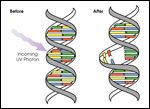Scientists Map Progression of Genetic Aberrations in the Evolution of Individual Cancers
Scientists at the University of California have taken patient tumor samples and compared them to matched normal tissue samples for two cancer types to map the evolution of mutations in cancer progression.
Scientists at the University of California have taken patient tumor samples and compared them to matched normal tissue samples for two cancer types to map the evolution of mutations in cancer progression.

Ultraviolet (UV) photons harm the DNA molecules of living organisms in different ways. In one common damage event, adjacent bases bond with each other, instead of across the "ladder." This makes a bulge, and the distorted DNA molecule does not function properly.
40 megabases of coding regions among 8 paired samples from cutaneous squamous cell carcinoma (cSCC) and ovarian cancer were sequenced and analyzed for various types of mutations. From this sequencing information, the researchers were able to reconstruct the evolutionary order of mutations in individual tumors.
The study found large numbers of simple mutations following the loss of the second copy of the TP53 gene in both cSSC and serous ovarian adenocarcinomas. The TP53 gene encodes the p53 protein which has many mechanisms of anticancer function and plays a role in apoptosis, genomic stability, and inhibition of angiogenesis. In its anti-cancer role, p53 works through several mechanisms to conserve genomic stability and prevent genomic mutations. It has thus been called the 'guardian of the genome". The study found that loss of the second copy of TP53 occurred earlier than later in most cases. The loss of the second TP53 allele was followed by a vast expansion of simple mutations, and in the case of cSCC, by secondary mutations in known and novel oncogenic pathways. These results promote a new model in which TP53 mutation occurs much earlier in the course of cancer progression than what was previously postulated.
Why This is Important
“We know that each cancer is a collection of genetic malfunctions,” said Raymond Cho, Ph.D., last author on the study and an assistant clinical professor in the department of dermatology at the University of California, San Francisco (UCSF). “We now show it is possible to determine which changes happen earlier and which ones happen further down the road, even in a single cancer.” The research is published in Cancer Discovery, one of the American Association for Cancer Research journals. The work is a collaboration of his laboratory at UCSF San Francisco, UCSF Berkley, Oregon Health & Science University, the Samsung Advanced Institute of Technology, as well as the Broad Institute of Harvard and MIT.
As characterizing tumors for specific mutations in order to tailor cancer treatments is becoming more prevalent, so is the sequencing of vast genomic regions of tumor samples. With the advent of faster and cheaper sequencing technology, scientists aim to study the evolution of cells from pre-cancerous lesions to metastatic disease to learn which mutations are necessary for continued cancer cell growth. This work will both facilitate our knowledge of the mechanisms that normal cells use to prevent cellular changes that can lead to cancer, as well as provide us with novel targets for drug development.
What's Next
Identifying the evolution of mutations from a normal cell to a precancerous lesion to an invasive cancer within an individual will facilitate our understanding of which mutations are crucial to cancer evolution and which mutations are merely "silent" mutations; along for the ride. “Although cancers carry many mutations, the ones that always happen earliest set the stage for additional abnormalities,” said Cho. The hurdle for this type of research is the small number of tissue samples from precancerous, early lesions to compare to invasive ones. Most early lesions are not identified clinically and it is currently not obvious which lesions have the potential to progress to malignant tumors. The vast heterogeneity of human cancers makes it difficult to generalize and large sample sizes will be necessary for each cancer type to identify the key mutations that drive and maintain oncogenesis.
Mapping the accumulation and changes in mutations during tumorigenesis of a cancer should provide diagnostic markers for early detection, which are greatly lacking for most cancer types.